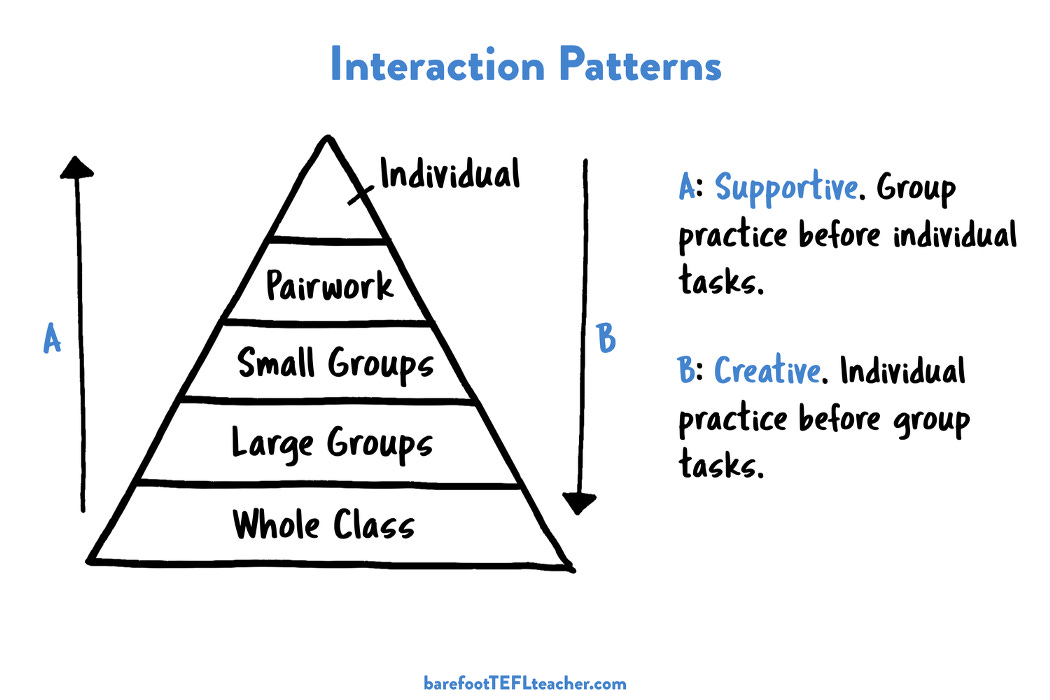How to Balance Your Lesson Plan
Balancing content, skills and interpersonal dynamics.

Balancing a lesson plan makes a class run more smoothly and provides more value to students.
To balance your plan, you need to choose activities based not just on their content (vocabulary, grammar, etc.) but also on three other factors:
Skills (listening, reading, speaking, writing)
Interaction patterns
Interpersonal relationships
Let’s take a look at these one at a time.
Skills
This should be pretty simple — ensure your lesson plan balances listening, speaking, reading and writing.
Although it’s a little more complex than that. Do you want to balance input and output in class? Or mainly focus on output? Do you want to include reading and writing during class time or assign it for homework? Unless you have a class of young learners who are struggling with phonics and learning to read.
The point is to consider your class, your students, and the skills they need to practice most. The time you have in class is the most valuable English practice time they’ll have all week, so make sure you make the most of it for them.
Interaction patterns
Interaction patterns describe the number of others that each student is interacting with. They can be split into the following general patterns:
Individual work
Pair work
Small group work
Large group work
Whole-Class
A good lesson plan will balance these patterns.
An excellent way to use interactions is to progress to different patterns as the task progresses. For example, if you’re doing a grammar review, you might want to elicit from the whole class first, rather than pick on individuals. Then you might work to notice differences in two example sentences in a small group. That might be followed by working in pairs to produce a new, correct sentence. Finally, learners would do an individual exercise to practice.
That progression would be a great example of ‘A’, below:
A. Reasons to start with a whole class activity: for a challenging activity that students might struggle with if you gave it to them as an individual activity immediately. The pyramid provides them with a chance to practice in a ‘safe’ group setting first, then ups the involvement during small group/pairwork, which should give them the confidence to do the activity by themselves.
Examples include: practicing for a substitution dialogue or any implicit or explicit grammar activity (e.g. changing present simple to past simple).
B. Reasons to start with individual work: to prepare for a larger group or whole class activity. Students can give their input, have it multiplied by working in pairs or small groups, and then participate in a whole class activity, such as a debate or any complex task-based activity.
Don’t feel that you have to use every stage of the pyramid — some classes need less support or preparation time than others. I rarely use every stage.
Interpersonal relationships
I include this as using the social dynamics of the students in the class can make or break a class, all other things being equal.
For example, it’s standard TEFL dogma to pair a stronger student with a weaker student so that the stronger student can help the weaker one. OK, how does the stronger student feel after five weeks of this? Happy and willing to help? Or frustrated, annoyed and unwilling to participate? It depends on their personality.
Some students don’t work well together, others do—cliques form and change. Stronger students like to work with others of their level and be called on to help peers. Naughty students’ excess energy can be channelled for a force for good (teacher’s helper, anyone?), while shyer students need extra encouragement from you, the teacher.
As a teacher, I’m sure we all do this to some degree, but making it a series of conscious decisions can help to smooth out your classes.
Of course, all these rules are suggestions, not rules. Be my guest if you want to break them with an epic task-based lesson that takes two or more hours. When you break the rules, do so for a good reason.
In closing
Balance your lesson plans. Think about your students when you consider which skills to teach, how to have the students interact, and how well they get on with their peers.
General CTA
If you liked this article, you’ll love my books:
📝 Lesson Planning for Language Teachers - Plan better, faster, and stress-free (4.5⭐, 175 ratings).
👩🎓 Essential Classroom Management - Develop calm students and a classroom full of learning (4.5⭐, 33 ratings).
🏰 Storytelling for Language Teachers - Use the power of storytelling to transform your lessons (4.5⭐, 11 ratings).
🤖 ChatGPT for Language Teachers - AI prompts and techniques for language teachers (4.5⭐, 10 ratings).
💭 Reflective Teaching Practice Journal - Improve your teaching in five minutes daily (4.5⭐, 16 ratings).



